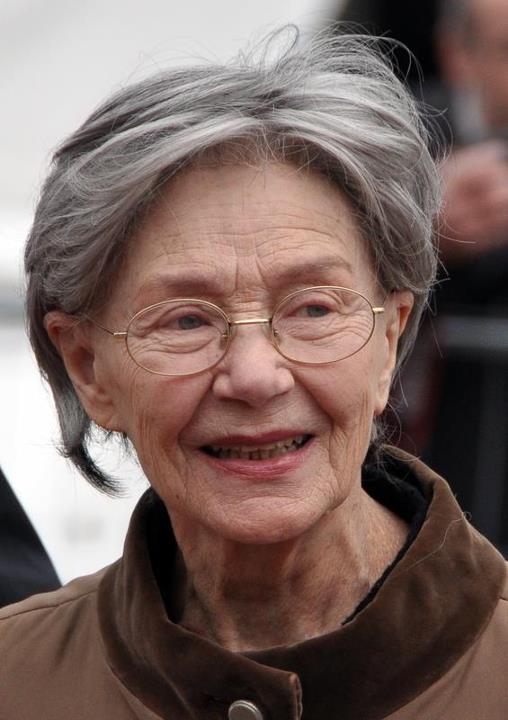Al Jazeera speaks with actress Emmanuelle Riva about ‘Hiroshima mon amour’ for its series on the 70th anniversary of the bombings of Hiroshima and Nagasaki
Blog originally published on Al Jazeera America – Aug. 6, 2015
“You’ve seen nothing of Hiroshima.” That’s the phrase uttered repeatedly at the opening of “Hiroshima, mon amour,” the 1959 film directed by French New Wave auteur Alain Resnais. Unlike the cinematic treatments of the carnage that came before, the film announces its own limits, telling not the story of the actual bombing, but the devastation felt in its aftermath by a French woman in Hiroshima and her Japanese lover.
Recently re-released by Criterion Collection ahead of the 70th anniversary of the bombings of Hiroshima and Nagasaki, the film continues to hammer that message into viewers today – You’ve seen nothing of Hiroshima.
In the first footage of Hiroshima, scientists, documentarians and military personnel endeavored to capture the realities of the carnage, just weeks after the August 6, 1945 bombing. A group of scientists and documentarians from Japanese studio Nichiei were the first to travel to Hiroshima to gather footage of obliterated homes and what life remained. A U.S. military team took more footage, and months later sent what they intended to be an accurate portrayal of the bombing’s effects back to the United States.
Years later, the 1950 Japanese film “Nagasaki no Kane” also attempted to convey the actual horrors of the bombing in what Shota Ogawa, a cineaste who teaches East Asian cinema at the University of North Carolina at Charlotte, describes as a “stylized sequence of the blast, which is framed as the protagonist’s flashback.”
Nearly a decade later, “Hiroshima, mon amour” – and in particular the first scene’s promise not to show what actually happened in the bombings of Hiroshima and Nagasaki – continues to leave “a strong impression on Japanese viewers,” Ogawa said.
“It is a bold gesture to yank Hiroshima away from the scientific endeavors of knowledge – represented by military, medical and other scientific documentaries – to excavate the poetic, emotive and affective dimension of our post-Hiroshima existence,” he added.
Emmanuelle Riva, who portrays the French woman in the film, admits that like the character she portrays, she saw nothing of the bombing of exactly seven decades ago that the film memorializes, even if she immersed herself in memories of intense suffering while shooting in Hiroshima a little over a decade after the United States dropped an atomic bomb on the city.
“No one can imagine the horror unless you were there and had it burned into your skin and soul – were physically touched and disfigured by it or witnessed firsthand the destruction of humanity and of innocence,” Riva told Al Jazeera. She spoke on the phone from her home in Paris, where she has resisted innovations like television or an Internet connection in favor of longer-standing communications tools like radio and newspapers.
At 88, more than 50 years after the film was produced, Riva still speaks in the same eerily quiet, lyrical tone with which she voiced the French-Japanese coproduction’s chilling opening scene – an affectation that, in uttering the names of Japanese rivers and valleys, seems to celebrate the light, rhythmic pitch that unites the Japanese and French tongues.
Set to a kind of dizzying waltz composed by Georges Delerue and Giovanni Fusco, the opening scene features the voices of Riva and her Japanese lover, played by Eiji Okada, overlaying the original footage of Hiroshima’s aftermath and reenactments from the Japanese film “Nagasaki no Kane’s” flashback sequence.
“The reenactments have been done with great attention to detail. The films have been made with great attention to detail. The illusion, quite simply, is so perfectly done that tourists cry. We can mock the tourists, but what else can a tourist do but cry?” Riva tells Okada.
“Tu n’as rien vu à Hiroshima” – “You saw nothing in Hiroshima,” Okada repeatedly tells Riva.
“There are plenty of people who ask themselves what was behind that scene,” said Riva of fans who continue to be mesmerized by that scene.
In the tradition of the New Wave cinema movements of the time in both France and Japan, the film appears to celebrate the limitations of art in depicting reality, in cheeky revolt against Hollywood. It’s a message that fits squarely with what the survivors’ descendants are saying about the event that will be commemorated Thursday: What happened is unthinkable.
But even without attempting to interpret the actual horrors of Hiroshima, it was poorly received by Japanese audiences, Riva said.
“It didn’t work in Japan,” she said. “They couldn’t handle a film on this issue at the time. It would have been too cruel to have to watch it.”
The film also met an unfriendly reception in the United States, she said. France’s Palme D’or – the top prize at the annual Cannes Film Festival – went to French-Brazilian co-production “Black Orpheus” in 1959, Riva believes, because post-war France “did not want to displease our American friends who dropped the bomb.”
Nearly sixty years after production, Riva says it’s time for both sides to face the film’s anti-war, anti-nuclear message head-on.
“We are destroying the world,” she says, wistfully. She said the film she made in her early 30s, though now well received, has yet to penetrate hearts and minds, amid what she described as a never-ending global race for the bomb.
Almost keen to realize her own limitations in conveying what happened at Hiroshima, Riva hopes that the film, one of the two that she says act as bookends to her career (along with 2012 Oscar-winner Amour), will continue to “serve a certain purpose.”
“It must help raise consciousness. It should be seen from childhood. It has to start from childhood, you see: The spirit of solidarity – the spirit of justice.”
